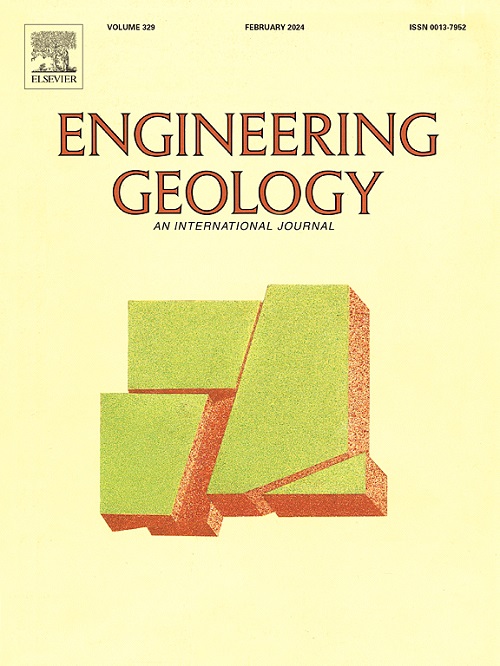Three-dimensional deformation inversion of mountain excavation and city construction areas using multi-track Sentinel-1 datasets and constraints of strain model and surface-parallel flow
IF 8.4
1区 工程技术
Q1 ENGINEERING, GEOLOGICAL
引用次数: 0
Abstract
Mountain Excavation and City Construction (MECC) projects are common in many mountainous areas to create construction land, but ground deformation during and after MECC projects has not been fully studied. Synthetic Aperture Radar Interferometry (InSAR) is an advanced spaceborne technology to monitor large coverage ground deformation, but existing studies have neglected its horizontal deformation especially in the north-south direction due to its insensibility. As the original terrain of the filling area in the MECC areas is “V” shaped, the filling body can be regarded as a man-made “landslide” with the original slope surface as the sliding subsurface, resulting in the three-dimensional (3D) ground deformation including horizontal and vertical compaction. In this study, an InSAR technique for 3D deformation inversion of MECC areas is proposed by multitrack Sentinel-1 datasets. Firstly, surface height changes and line-of-sight (LOS) deformation are dynamically estimated in the MECC area. Then, the 3D deformation is estimated using strain model (SM) and surface-parallel flow (SPF) constraints. The results of the MECC area in Lanzhou city, China, show that the surface height changes in the MECC area range from −100 m to 75 m, along with the deformation rates in the east-west, north-south, and vertical directions amounting to 110, 80, and 180 mm/year, respectively. The magnitude of vertical deformation is positively correlated to the thickness of the filling loess, with the correlation coefficient of 0.7. Furthermore, the magnitude of the horizontal deformation is positively correlated to the gradient of the thickness of the filling loess, with the correlation coefficient of 0.7 and 0.36 in the east-west and north-south directions, respectively. Finally, the finite difference model (FDM) is employed to simulate the consolidation process in the high fill areas. The real experiments and FDM revealed that the high fill areas experienced both vertical and horizontal deformation, where horizontal consolidation of the filling loess causes the deformation fluctuations in the InSAR LOS direction at the bottom of the ravine.
基于多轨Sentinel-1数据集的山地开挖和城市建设区域三维变形反演及应变模型和地表平行流约束
山地开挖与城市建设(MECC)工程是许多山区普遍存在的创造建设用地的工程,但MECC工程期间和之后的地面变形研究并不充分。合成孔径雷达干涉测量技术(InSAR)是一种先进的监测大覆盖地面变形的星载技术,但现有研究由于其不敏感而忽略了其水平变形,特别是南北方向的水平变形。由于MECC地区充填区原地形呈“V”形,充填体可视为人为“滑坡”,原坡面为滑动次地表,造成地面三维变形,包括水平压实和垂直压实。本文提出了一种利用Sentinel-1多航迹数据集进行MECC区域三维形变反演的InSAR技术。首先,动态估计MECC区域的地表高度变化和视距(LOS)变形;然后,利用应变模型(SM)和表面平行流动(SPF)约束估计三维变形。结果表明,兰州MECC地区地表高度变化范围为−100 m ~ 75 m,东西、南北和垂直方向的变形速率分别为110、80和180 mm/年。竖向变形强度与填土厚度呈正相关,相关系数为0.7。水平变形强度与填充物厚度梯度呈正相关,东西、南北方向的相关系数分别为0.7和0.36。最后,采用有限差分模型(FDM)对高填区固结过程进行了数值模拟。实际试验和FDM结果表明,高填方区存在垂直和水平变形,其中填方黄土的水平固结引起沟底InSAR LOS方向的变形波动。
本文章由计算机程序翻译,如有差异,请以英文原文为准。
求助全文
约1分钟内获得全文
求助全文
来源期刊

Engineering Geology
地学-地球科学综合
CiteScore
13.70
自引率
12.20%
发文量
327
审稿时长
5.6 months
期刊介绍:
Engineering Geology, an international interdisciplinary journal, serves as a bridge between earth sciences and engineering, focusing on geological and geotechnical engineering. It welcomes studies with relevance to engineering, environmental concerns, and safety, catering to engineering geologists with backgrounds in geology or civil/mining engineering. Topics include applied geomorphology, structural geology, geophysics, geochemistry, environmental geology, hydrogeology, land use planning, natural hazards, remote sensing, soil and rock mechanics, and applied geotechnical engineering. The journal provides a platform for research at the intersection of geology and engineering disciplines.
 求助内容:
求助内容: 应助结果提醒方式:
应助结果提醒方式:


